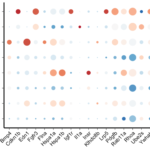R is a powerful language used for statistical computing and data analysis. It is a versatile language for statistical computing and graphics. It offers tools like the One Sample T Test for hypothesis testing and calculating Standard Deviation for data variability assessment. In bioinformatics, R is indispensable for genomic data analysis, enabling researchers to unravel biological insights. Additionally, R provides functions like Partial Correlation and If Else R Programming for advanced data manipulation and conditional logic implementation.
One of the most useful functions in R is the seq function. The Seq Function in R helps you create sequences of numbers. This is very handy for a wide range of tasks, from indexing to creating time series data. In this guide, we will dive deep into the Seq Function in R, explore its syntax, and look at numerous examples.
Introduction to the Seq Function in R
The Seq Function in R is part of the base R package, meaning you can use it without needing any additional libraries. It generates regular sequences of numbers, which are essential in various data manipulation and analysis tasks.
Basic Syntax of the Seq Function in R
The basic syntax of the seq function is straightforward:
seq(from, to, by, length.out, along.with)
Here is what each parameter means:
from: The starting value of the sequence.to: The ending value of the sequence.by: The increment of the sequence.length.out: The desired length of the sequence.along.with: Generates a sequence along the length of another object.
Simple Examples of Seq Function in R
Let’s start with some simple examples to understand how the Seq Function in R works.
Example 1: Creating a Simple Sequence
seq(1, 10)
Output:
[1] 1 2 3 4 5 6 7 8 9 10
This will generate a sequence of numbers from 1 to 10 using the Seq Function in R.
Example 2: Creating a Sequence with a Specific Increment
seq(1, 10, by=2)
Output:
[1] 1 3 5 7 9
This will generate a sequence of numbers from 1 to 10, incremented by 2. So, the output will be: 1, 3, 5, 7, 9. This demonstrates the flexibility of the R Seq function.
Example 3: Creating a Sequence of a Specific Length
seq(1, 10, length.out=5)
Output:
[1] 1.00 3.25 5.50 7.75 10.00
This will generate a sequence from 1 to 10 with exactly 5 elements using the Seq Function in R. The output will be approximately: 1, 3.25, 5.5, 7.75, 10.
Advanced Usage of Seq Function in R
The Seq Function in R can also be used in more complex scenarios. Here are some advanced examples to showcase its versatility.
Generating Sequences Along a Vector
Example 4: Using along.with
If you have a vector and you want to create a sequence of the same length, you can use along.with in Seq in R.
vector <- c(5, 10, 15, 20) seq(along.with=vector)
Output:
[1] 1 2 3 4
This will generate a sequence of the same length as the vector: 1, 2, 3, 4, using the R Seq Function.
Using Negative Increments
Example 5: Creating a Decreasing Sequence
You can also create sequences that decrease by specifying a negative by value in the Seq Function in R.
seq(10, 1, by=-1)
Output:
[1] 10 9 8 7 6 5 4 3 2 1
This will generate a sequence from 10 to 1: 10, 9, 8, 7, 6, 5, 4, 3, 2, 1, demonstrating the flexibility of Seq in R.
Combining Seq with Other Functions
The Seq Function in R can be combined with other functions to perform more complex operations.
Example 6: Generating Sequences for Plotting
x <- seq(0, 2*pi, length.out=100) y <- sin(x) plot(x, y, type='l')
This will generate a sine wave plot using 100 points between 0 and 2π2\pi2π. The R Seq function makes it easy to create such sequences.
Example 7: Creating Date Sequences
start_date <- as.Date("2021-01-01") end_date <- as.Date("2021-01-10") date_seq <- seq(start_date, end_date, by="day")
Output:
[1] "2021-01-01" "2021-01-02" "2021-01-03" "2021-01-04" "2021-01-05" "2021-01-06" "2021-01-07" "2021-01-08" "2021-01-09" "2021-01-10"
This will generate a sequence of dates from January 1, 2021, to January 10, 2021 using Seq Function in R.
Practical Applications of Seq Function in R
The Seq Function in R is not just about generating sequences; it can be applied in various practical scenarios. Here are a few examples to illustrate its real-world usage.
Example 8: Indexing Data Frames
Suppose you have a data frame, and you want to create an index column.
df <- data.frame(name=c("Alice", "Bob", "Charlie"), age=c(25, 30, 35)) df$index <- seq(1, nrow(df))
Output:
name age index 1 Alice 25 1 2 Bob 30 2 3 Charlie 35 3
This adds an index column to the data frame using the R Seq Function.
Example 9: Generating Time Series Data
time_series <- seq(from=as.POSIXct("2021-01-01 00:00"), to=as.POSIXct("2021-01-01 23:00"), by="hour")
Output:
[1] "2021-01-01 00:00:00 UTC" "2021-01-01 01:00:00 UTC" "2021-01-01 02:00:00 UTC" "2021-01-01 03:00:00 UTC" "2021-01-01 04:00:00 UTC" [6] "2021-01-01 05:00:00 UTC" "2021-01-01 06:00:00 UTC" "2021-01-01 07:00:00 UTC" "2021-01-01 08:00:00 UTC" "2021-01-01 09:00:00 UTC" [11] "2021-01-01 10:00:00 UTC" "2021-01-01 11:00:00 UTC" "2021-01-01 12:00:00 UTC" "2021-01-01 13:00:00 UTC" "2021-01-01 14:00:00 UTC" [16] "2021-01-01 15:00:00 UTC" "2021-01-01 16:00:00 UTC" "2021-01-01 17:00:00 UTC" "2021-01-01 18:00:00 UTC" "2021-01-01 19:00:00 UTC" [21] "2021-01-01 20:00:00 UTC" "2021-01-01 21:00:00 UTC" "2021-01-01 22:00:00 UTC" "2021-01-01 23:00:00 UTC"
This generates an hourly time series for one day using Seq Function in R.
Example 10: Creating Factor Levels
You can use the Seq Function in R to create factor levels for categorical data.
levels <- seq(from=1, to=5, by=1) factor_data <- factor(c(1, 2, 3, 4, 5), levels=levels)
Output:
[1] 1 2 3 4 5 Levels: 1 2 3 4 5
Exploring More Parameters
The Seq Function in R has a few other useful parameters and tricks.
Using along.with Parameter
The along.with parameter generates a sequence of the same length as the specified vector.
Example 11: Matching Lengths
vector <- c(100, 200, 300, 400) seq(along.with=vector)
Output:
[1] 1 2 3 4
This generates a sequence: 1, 2, 3, 4 using Seq in R.
Using length.out Parameter
The length.out parameter defines the length of the sequence.
Example 12: Specific Length Sequence
seq(1, 2, length.out=8)
Output:
[1] 1.000 1.143 1.286 1.429 1.571 1.714 1.857 2.000
This generates a sequence from 1 to 2 with 8 elements using the Seq Function in R.
Combining Seq with Other Functions
Combining the Seq Function in R with other functions can produce powerful results.
Example 13: Generating Sequences for Simulation
simulations <- seq(1, 100, by=1) results <- lapply(simulations, function(x) rnorm(10, mean=x))
Output:
[[1]] [1] 0.04115883 -0.66460754 -0.18950059 1.15045292 -1.23130356 -0.29517790 -1.62061960 1.78821103 -0.47574734 -0.64991682 [[2]] [1] 0.8227559 1.6991386 1.2198032 0.7651488 0.8491868 -0.1260055 0.0586761 2.2346612 1.7930557 0.7949361 ... [[100]] [1] 100.4727 100.1311 99.8752 99.5355 99.3765 99.4866 99.8268 99.5652 98.9997 99.4241
This runs 100 simulations of generating 10 random normal variables with means from 1 to 100.
Example 14: Using Seq in Data Manipulation
data <- data.frame(value=seq(1, 100, by=1)) data$group <- cut(data$value, breaks=seq(0, 100, by=10), labels=FALSE)
Output:
value group 1 1 1 2 2 1 3 3 1 4 4 1 5 5 1 6 6 1 7 7 1 8 8 1 9 9 1 10 10 1 11 11 2 12 12 2 ... 91 91 10 92 92 10 93 93 10 94 94 10 95 95 10 96 96 10 97 97 10 98 98 10 99 99 10 100 100 10
This splits the data into groups of 10 using the R Seq Function.
Summary
The Seq Function in R is a fundamental tool that offers great flexibility and power. From creating simple sequences to generating complex time series, its applications are vast. Whether you are indexing data, creating plots, or generating factors, the Seq Function in R can simplify your tasks and enhance your data analysis capabilities.
Understanding and mastering the Seq Function in R will undoubtedly make your work in R more efficient and effective. By using the examples and concepts covered in this guide, you can harness the full potential of the Seq Function in R for your data manipulation and analysis needs.



